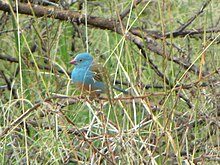Blueheaded deer
| Blueheaded deer | ||||||||||||
|---|---|---|---|---|---|---|---|---|---|---|---|---|

Blue-headed feral ( Uraeginthus cyanocephalus ) |
||||||||||||
| Systematics | ||||||||||||
|
||||||||||||
| Scientific name | ||||||||||||
| Uraeginthus cyanocephalus | ||||||||||||
| ( Richmond , 1897) |
The blue-headed tiger ( Uraeginthus cyanocephalus ), also known as the blue-headed butterfly finch , is a species of the genus of the blue-headed tiger . There are no subspecies differentiated for this African finch species.
Appearance
The blue-headed deer reaches a body length of 14 centimeters and is one of the large species of finch. It is a close relative of the blue tiger ( Uraeginthus angolensis ). Both species lack the red ear patches of the common butterfly asterisk ( Uraeginthus bengalus ); The males of the blue-headed tiger also lack the gray markings of the head plate and neck, they have a completely blue head. The color is more intense than that of the blue tiger. The brown on the side of the body is yellowish and the under tail-coverts are vivid light yellow-brown. The eyes are reddish and the beak is red too.
The female is only blue on the forehead on the top of the head, otherwise it is brown. Some individuals even completely lack the blue on the top of the head, they only have a little blue on the sides of the body.
Distribution and way of life
The blue-headed deer is only native to East Africa. It occurs from southern Ethiopia and Somalia through Kenya and the northern half of Tanzania . Its habitat are savannahs with light acacia vegetation near bodies of water and semi-deserts. In Kenya, its elevation ranges up to 1,300 meters. In other regions of its distribution area, it comes to short grass savannahs up to 2000 meters above sea level. NN before. Blaukopfastrilde live in pairs or in small schools. They are often associated with blue and butterfly and occasionally with the Senegalese amaranth.
The breeding season varies depending on the distribution area. As with all species of the genus, courtship is a halmbalz. The nest is built in low bushes and is often located near wasp nests. This behavior is also shown by the asterisk . Blaukopfastrilden also occasionally use old nests of weaver birds. The clutch consists of four to six eggs. The breeding season is 13 to 14 days. In the first few days after hatching, the adult birds mainly feed insects and only after about seven days do they begin to bring semi-ripe seeds to the young birds. The young birds leave the nest at 18 to 19 days. The juvenile moults have completed the young birds at around three months and can then no longer be distinguished from the adult birds based on their plumage.
attitude
The Blaukopfastrild was first imported to Europe in 1927. The first import country was England, from there individuals of this species also made it to Germany and France. The first breeding took place in France in 1930. In terms of its keeping requirements, the butterfly eel corresponds to the butterfly eel and the blue eel.
literature
- Horst Bielfeld : Knowing and caring for 300 ornamental birds. Ulmer Verlag, Stuttgart 2009, ISBN 978-3-8001-5737-2 .
- Jürgen Nicolai (Ed.), Joachim Steinbacher (Ed.), Renate van den Elzen, Gerhard Hofmann, Claudia Mettke-Hofmann: Prachtfinken - Afrika , Series Handbuch der Vogelpflege, Eugen Ulmer Verlag, Stuttgart 2007, ISBN 978-3-8001- 4964-3
Web links
- Uraeginthus cyanocephalus in the endangered Red List species the IUCN 2008. Posted by: BirdLife International, 2008. Accessed on December 20 of 2008.
